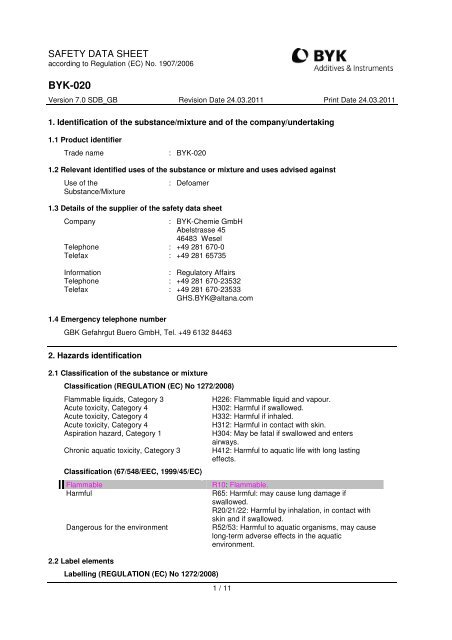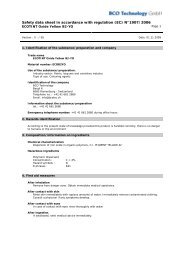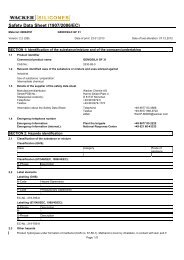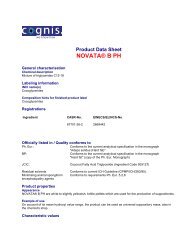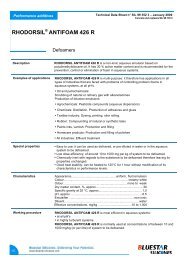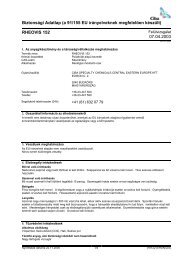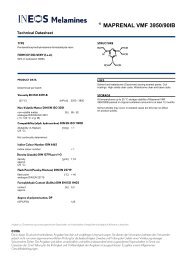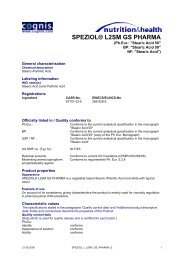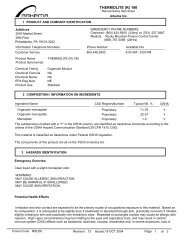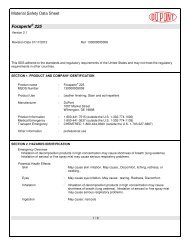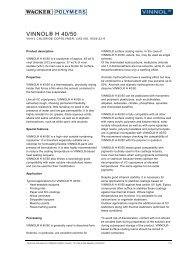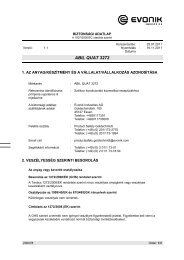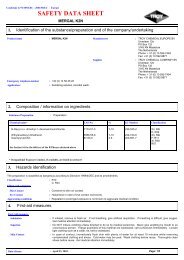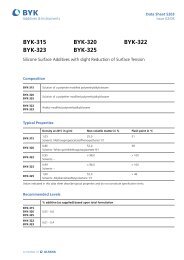BYK-020
BYK-020
BYK-020
- No tags were found...
You also want an ePaper? Increase the reach of your titles
YUMPU automatically turns print PDFs into web optimized ePapers that Google loves.
SAFETY DATA SHEETaccording to Regulation (EC) No. 1907/2006<strong>BYK</strong>-<strong>020</strong>Version 7.0 SDB_GB Revision Date 24.03.2011 Print Date 24.03.20111. Identification of the substance/mixture and of the company/undertaking1.1 Product identifierTrade name: <strong>BYK</strong>-<strong>020</strong>1.2 Relevant identified uses of the substance or mixture and uses advised againstUse of theSubstance/Mixture: Defoamer1.3 Details of the supplier of the safety data sheetCompany: <strong>BYK</strong>-Chemie GmbHAbelstrasse 4546483 WeselTelephone : +49 281 670-0Telefax : +49 281 65735Information: Regulatory AffairsTelephone : +49 281 670-23532Telefax : +49 281 670-23533GHS.<strong>BYK</strong>@altana.com1.4 Emergency telephone numberGBK Gefahrgut Buero GmbH, Tel. +49 6132 844632. Hazards identification2.1 Classification of the substance or mixtureClassification (REGULATION (EC) No 1272/2008)Flammable liquids, Category 3Acute toxicity, Category 4Acute toxicity, Category 4Acute toxicity, Category 4Aspiration hazard, Category 1Chronic aquatic toxicity, Category 3Classification (67/548/EEC, 1999/45/EC)FlammableHarmfulDangerous for the environment2.2 Label elementsLabelling (REGULATION (EC) No 1272/2008)H226: Flammable liquid and vapour.H302: Harmful if swallowed.H332: Harmful if inhaled.H312: Harmful in contact with skin.H304: May be fatal if swallowed and entersairways.H412: Harmful to aquatic life with long lastingeffects.R10: Flammable.R65: Harmful: may cause lung damage ifswallowed.R20/21/22: Harmful by inhalation, in contact withskin and if swallowed.R52/53: Harmful to aquatic organisms, may causelong-term adverse effects in the aquaticenvironment.1 / 11
SAFETY DATA SHEETaccording to Regulation (EC) No. 1907/2006<strong>BYK</strong>-<strong>020</strong>Version 7.0 SDB_GB Revision Date 24.03.2011 Print Date 24.03.2011Hazard pictograms :Signal word: DangerHazard statements : H226 Flammable liquid and vapour.H302Harmful if swallowed.H304May be fatal if swallowed and entersairways.H312Harmful in contact with skin.H332Harmful if inhaled.H412Harmful to aquatic life with long lastingeffects.Precautionary statements: Prevention:P210P273P280Response:P301 + P310Keep away from heat/sparks/openflames/hot surfaces. - No smoking.Avoid release to the environment.Wear protective gloves/ protective clothing/eye protection/ face protection.IF SWALLOWED: Immediately call aPOISON CENTER or doctor/ physician.P303 + P361 + P353 IF ON SKIN (or hair): Remove/ Takeoff immediately all contaminated clothing.Rinse skin with water/ shower.P331Do NOT induce vomiting.Storage:P403 + P235 Store in a well-ventilated place. Keep cool.Hazardous components which must be listed on the label:• 111-76-2 2-butoxyethanol• 64742-82-1 low boiling point hydrogen treated naphtha3. Composition/information on ingredients3.2 MixturesChemical nature: Solution of foam destroying polysiloxanesHazardous componentsChemical Name CAS-No.EC-No.Registrationnumber2-butoxyethanol 111-76-2203-905-0/ /Classification(67/548/EEC)Xn; R20/21/22Xi; R36/382 / 11Classification(REGULATION(EC) No1272/2008)Acute Tox. 4; H332Acute Tox. 4; H312Acute Tox. 4; H302Concentration[%]>= 50 -
SAFETY DATA SHEETaccording to Regulation (EC) No. 1907/2006<strong>BYK</strong>-<strong>020</strong>Version 7.0 SDB_GB Revision Date 24.03.2011 Print Date 24.03.2011Eye Irrit. 2; H319Skin Irrit. 2; H3152-ethylhexan-1-ol 104-76-7203-234-3/low boiling pointhydrogen treatednaphtha64742-82-1265-185-4Xi; R36/38N; R51/53Xn; R65R10R66R67Skin Irrit. 2; H315Eye Irrit. 2; H319STOT SE 3; H336Asp. Tox. 1; H304Aquatic Chronic 2;H411>= 20 - < 25>= 10 - < 12,5oct-1-ene 111-66-<strong>020</strong>3-893-7/F; R11Xi; R38N; R51/53Xn; R65Flam. Liq. 2; H225Skin Irrit. 2; H315Asp. Tox. 1; H304Aquatic Chronic 2;H411>= 0,1 - < 0,25For the full text of the R-phrases mentioned in this Section, see Section 16.For the full text of the H-Statements mentioned in this Section, see Section 16.4. First aid measures4.1 Description of first aid measuresGeneral advice: Move out of dangerous area.Show this safety data sheet to the doctor in attendance.Symptoms of poisoning may only appear several hours later.Do not leave the victim unattended.If inhaledIn case of skin contactIn case of eye contactIf swallowed: Consult a physician after significant exposure.If unconscious place in recovery position and seek medicaladvice.: Take victim immediately to hospital.If on skin, rinse well with water.If on clothes, remove clothes.: Flush eyes with water as a precaution.Remove contact lenses.Protect unharmed eye.Keep eye wide open while rinsing.If eye irritation persists, consult a specialist.: Keep respiratory tract clear.Do NOT induce vomiting.Do not give milk or alcoholic beverages.Never give anything by mouth to an unconscious person.If symptoms persist, call a physician.Take victim immediately to hospital.3 / 11
SAFETY DATA SHEETaccording to Regulation (EC) No. 1907/2006<strong>BYK</strong>-<strong>020</strong>Version 7.0 SDB_GB Revision Date 24.03.2011 Print Date 24.03.20115. Fire-fighting measures5.1 Extinguishing mediaSuitable extinguishing media: Alcohol-resistant foamCarbon dioxide (CO2)Dry chemicalUnsuitable extinguishing : High volume water jetmedia5.2 Special hazards arising from the substance or mixtureSpecific hazards during firefighting: Do not allow run-off from fire fighting to enter drains or watercourses.5.3 Advice for firefightersSpecial protective equipmentfor fire-fightersFurther information: Wear self contained breathing apparatus for fire fighting ifnecessary.: Collect contaminated fire extinguishing water separately. Thismust not be discharged into drains.Fire residues and contaminated fire extinguishing water mustbe disposed of in accordance with local regulations.For safety reasons in case of fire, cans should be storedseparately in closed containments.Use a water spray to cool fully closed containers.6. Accidental release measures6.1 Personal precautions, protective equipment and emergency proceduresPersonal precautions: Use personal protective equipment.Ensure adequate ventilation.Remove all sources of ignition.Evacuate personnel to safe areas.Beware of vapours accumulating to form explosiveconcentrations. Vapours can accumulate in low areas.6.2 Environmental precautionsEnvironmental precautions: Prevent product from entering drains.Prevent further leakage or spillage if safe to do so.If the product contaminates rivers and lakes or drains informrespective authorities.6.3 Methods and materials for containment and cleaning upMethods for cleaning up: Contain spillage, and then collect with non-combustibleabsorbent material, (e.g. sand, earth, diatomaceous earth,vermiculite) and place in container for disposal according tolocal / national regulations (see section 13).4 / 11
SAFETY DATA SHEETaccording to Regulation (EC) No. 1907/2006<strong>BYK</strong>-<strong>020</strong>Version 7.0 SDB_GB Revision Date 24.03.2011 Print Date 24.03.20117. Handling and storage7.1 Precautions for safe handlingAdvice on safe handlingAdvice on protection againstfire and explosion: Avoid formation of aerosol.Do not breathe vapours/dust.Avoid contact with skin and eyes.For personal protection see section 8.Smoking, eating and drinking should be prohibited in theapplication area.Take precautionary measures against static discharges.Provide sufficient air exchange and/or exhaust in work rooms.Open drum carefully as content may be under pressure.Dispose of rinse water in accordance with local and nationalregulations.: Do not spray on a naked flame or any incandescent material.Take necessary action to avoid static electricity discharge(which might cause ignition of organic vapours).Keep away from open flames, hot surfaces and sources ofignition.7.2 Conditions for safe storage, including any incompatibilitiesRequirements for storageareas and containers: No smoking.Keep container tightly closed in a dry and well-ventilatedplace.Containers which are opened must be carefully resealed andkept upright to prevent leakage.Observe label precautions.Electrical installations / working materials must comply withthe technological safety standards.Other data: No decomposition if stored and applied as directed.8. Exposure controls/personal protection8.1 Control parametersComponents CAS-No. ValueControlparameters2-111-76-2 TWA 20 ppmbutoxyethano98 mg/m3lUpdateBasis2000-06-16 2000/39/ECFurtherinformation: skin: Identifies the possibility of significant uptake through the skinIndicativeSTEL50 ppm246 mg/m35 / 112000-06-16 2000/39/EC
SAFETY DATA SHEETaccording to Regulation (EC) No. 1907/2006<strong>BYK</strong>-<strong>020</strong>Version 7.0 SDB_GB Revision Date 24.03.2011 Print Date 24.03.2011Furtherinformation: skin: Identifies the possibility of significant uptake through the skinIndicativeTWA 25 ppm 2005-04-06 GB EH40Furtherinformation: Sk: Can be absorbed through skin. The assigned substances are those for which there areconcerns that dermal absorption will lead to systemic toxicity.STEL 50 ppm 2005-04-06 GB EH40Furtherinformation: Sk: Can be absorbed through skin. The assigned substances are those for which there areconcerns that dermal absorption will lead to systemic toxicity.8.2 Exposure controlsPersonal protective equipmentRespiratory protection: In the case of vapour formation use a respirator with anapproved filter.Hand protection: 4HBreak through time: 240 min: The suitability for a specific workplace should be discussedwith the producers of the protective gloves.Eye protectionSkin and body protectionHygiene measures: Eye wash bottle with pure waterTightly fitting safety goggles: impervious clothingChoose body protection according to the amount andconcentration of the dangerous substance at the work place.: When using do not eat or drink.When using do not smoke.Wash hands before breaks and at the end of workday.Environmental exposure controlsGeneral advice: Prevent product from entering drains.Prevent further leakage or spillage if safe to do so.If the product contaminates rivers and lakes or drains informrespective authorities.6 / 11
SAFETY DATA SHEETaccording to Regulation (EC) No. 1907/2006<strong>BYK</strong>-<strong>020</strong>Version 7.0 SDB_GB Revision Date 24.03.2011 Print Date 24.03.20119. Physical and chemical properties9.1 Information on basic physical and chemical propertiesAppearance: liquidColour: colourlessOdour: solvent-likeFlash point : 50,00 °CMethod: 48 (Abel-Pensky)Ignition temperature : 210,00 °CMethod: calculatedLower explosion limitUpper explosion limitpHMelting point/range: 0 %(V): 12,70 %(V): no data available: no data availableInitial boiling point : 144,00 °CVapour pressureDensityBulk densityWater solubilityViscosity, kinematic: 1,1000000 hPaat 20,00 °CMethod: calculated: 0,8800 g/cm3at 20,00 °CMethod: 4 (20°C Biegeschwinger): not applicable: immiscible: < 5,000 mm2/sat 20,00 °C5 mm2/sat 40,00 °CSurface tension: < 25,00 mN/mMethod: Dynometer (Ringmethode)10. Stability and reactivity10.1 Reactivity10.2 Chemical stability7 / 11
SAFETY DATA SHEETaccording to Regulation (EC) No. 1907/2006<strong>BYK</strong>-<strong>020</strong>Version 7.0 SDB_GB Revision Date 24.03.2011 Print Date 24.03.201110.3 Possibility of hazardous reactionsHazardous reactions: No decomposition if stored and applied as directed.: Vapours may form explosive mixture with air.10.4 Conditions to avoidConditions to avoid: Heat, flames and sparks.10.5 Incompatible materials10.6 Hazardous decomposition productsHazardous decompositionproducts: Carbon oxides11. Toxicological information11.1 Information on toxicological effectsAcute toxicityAcute oral toxicity: LD50: 1.450,00 mg/kgSpecies: ratMethod: OECD Test Guideline 401Acute inhalation toxicityAcute dermal toxicitySkin corrosion/irritationSkin irritation: Acute toxicity estimate: 18,39 mg/lMethod: Calculation method: Acute toxicity estimate: 1.839,46 mg/kgMethod: Calculation method: Species: rabbitResult: No skin irritationMethod: OECD Test Guideline 404Serious eye damage/eye irritationEye irritationRespiratory or skin sensitizationSensitisation: Species: rabbitResult: No eye irritationMethod: OECD Test Guideline 405: no data availableTarget Organ Systemic Toxicant - Repeated exposure: no data available12. Ecological information12.1 Toxicity8 / 11
SAFETY DATA SHEETaccording to Regulation (EC) No. 1907/2006<strong>BYK</strong>-<strong>020</strong>Version 7.0 SDB_GB Revision Date 24.03.2011 Print Date 24.03.2011Toxicity to fish :no data available12.2 Persistence and degradabilityBiodegradability: no data available12.3 Bioaccumulative potentialBioaccumulation12.4 Mobility in soilSurface tension: no data available: < 25,00 mN/mMethod: Dynometer (Ringmethode)12.5 Results of PBT and vPvB assessment12.6 Other adverse effectsAdditional ecologicalinformation: An environmental hazard cannot be excluded in the event ofunprofessional handling or disposal.Harmful to aquatic life with long lasting effects.13. Disposal considerations13.1 Waste treatment methodsProductContaminated packaging: The product should not be allowed to enter drains, watercourses or the soil.Do not contaminate ponds, waterways or ditches withchemical or used container.Send to a licensed waste management company.: Empty remaining contents.Dispose of as unused product.Do not re-use empty containers.Do not burn, or use a cutting torch on, the empty drum.14. Transport informationLand transportADR / RID:Class: 3Packaging group: IIIUN number: 1268ADR/RID-Labels: 3Description of the goods: PETROLEUM DISTILLATES, N.O.S.Sea transport9 / 11
SAFETY DATA SHEETaccording to Regulation (EC) No. 1907/2006<strong>BYK</strong>-<strong>020</strong>Version 7.0 SDB_GB Revision Date 24.03.2011 Print Date 24.03.2011IMDG:Class: 3Packaging group: IIIUN number: 1268Labels: 3EmS:F-E S-EDescription of the goods: PETROLEUM DISTILLATES, N.O.S.Marine pollutantnoAir transportIATA-DGR :Class: 3Packaging group: IIIUN/ID No.: UN 1268Labels: 3Description of the goods: Petroleum distillates, n.o.s.15. Regulatory information15.1 Safety, health and environmental regulations/legislation specific for the substance or mixtureMajor Accident HazardLegislation: 96/82/EC Update: 2003Flammable.6Quantity 1: 5.000 tQuantity 2: 50.000 t: 96/82/EC Update: 2003Petroleum products: (a) gasolines and naphthas, (b)kerosenes (including jet fuels), (c) gas oils (including dieselfuels, home heating oils and gas oil blending streams)13Quantity 1: 2.500 tQuantity 2: 25.000 t15.2 Chemical Safety Assessment16. Other informationFull text of R-phrases referred to under sections 2 and 310 / 11
SAFETY DATA SHEETaccording to Regulation (EC) No. 1907/2006<strong>BYK</strong>-<strong>020</strong>Version 7.0 SDB_GB Revision Date 24.03.2011 Print Date 24.03.2011R10Flammable.R11Highly flammable.R20/21/22Harmful by inhalation, in contact with skin and if swallowed.R36/38 Irritating to eyes and skin.R38Irritating to skin.R51/53 Toxic to aquatic organisms, may cause long-term adverse effects in theaquatic environment.R52/53 Harmful to aquatic organisms, may cause long-term adverse effects inthe aquatic environment.R65Harmful: may cause lung damage if swallowed.R66Repeated exposure may cause skin dryness or cracking.R67Vapours may cause drowsiness and dizziness.Full text of H-Statements referred to under sections 2 and 3.H225H226H302H304H312H315H319H332H336H411H412Highly flammable liquid and vapour.Flammable liquid and vapour.Harmful if swallowed.May be fatal if swallowed and enters airways.Harmful in contact with skin.Causes skin irritation.Causes serious eye irritation.Harmful if inhaled.May cause drowsiness or dizziness.Toxic to aquatic life with long lasting effects.Harmful to aquatic life with long lasting effects.The information contained herein is based on the present state of our knowledge and doestherefore not guarantee certain properties.11 / 11


